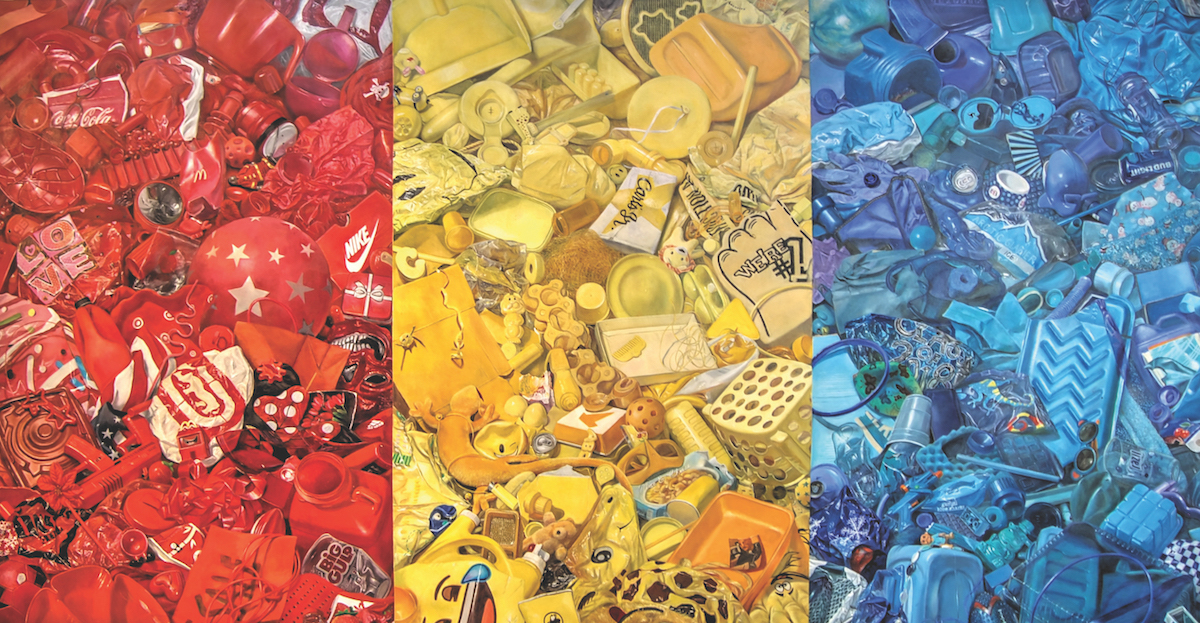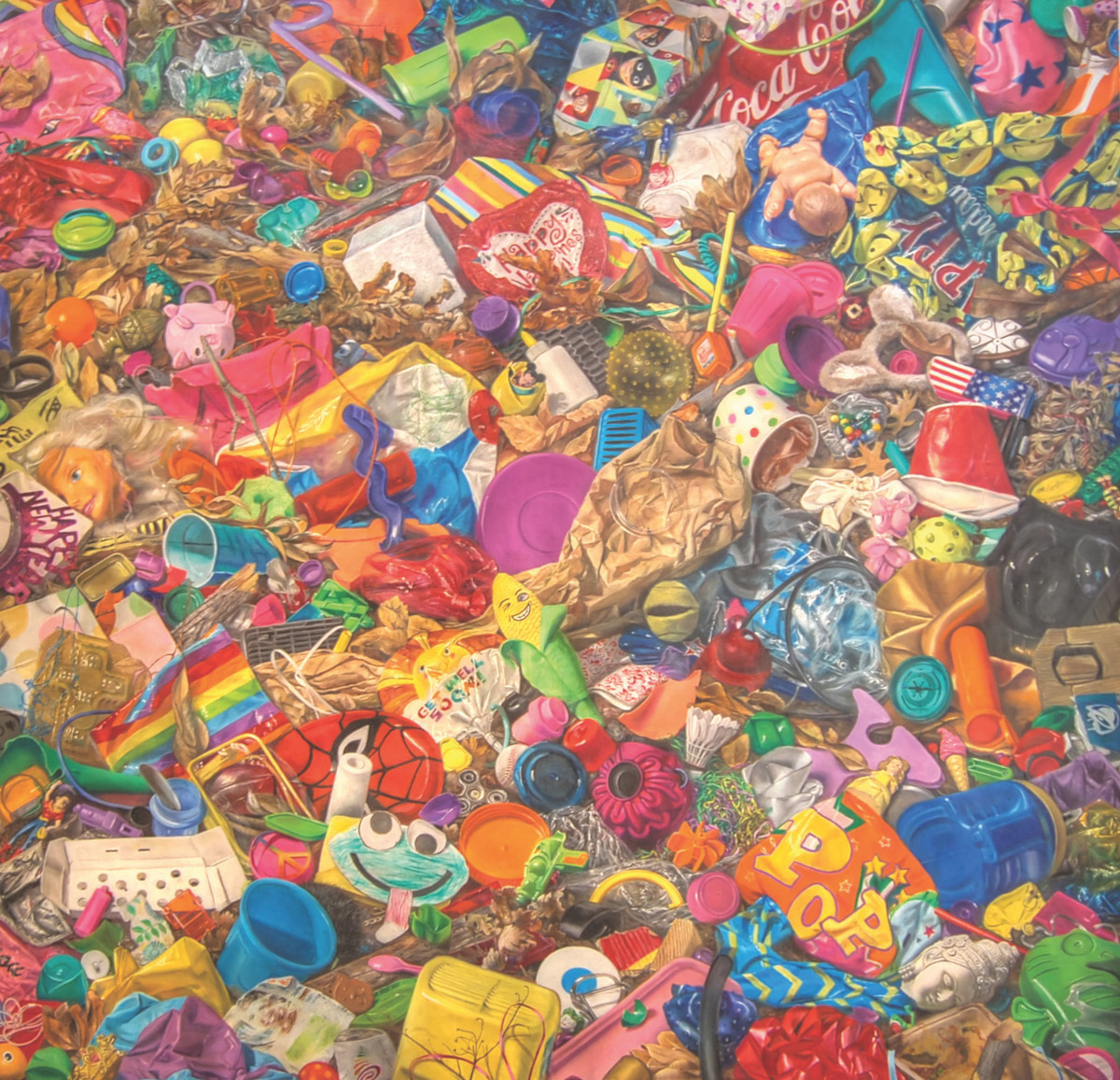Constance Mallinson’s career has spanned the many vicissitudes of the art world, from Minimalism to Pattern and Decoration, through to postmodern conceptual strategies. More recently, she has created a form of realistic painting that draws from Modernist Abstraction rather than the figurative tradition, and which offers an original alternative to the currently popular trend of pictorial and illustrative painting.
David DiMichele: I’d like to start by discussing your current and most recent large scale, highly representational oil paintings based on plastic detritus you collect on walks in your neighborhood. The plastic fragments are often combined with natural forms, such as leaves, roots and branches. These works interest me partly because of their dichotomy. On the one hand, they seem to be in the tradition of social realism in the way they use techniques of representation to draw attention to sociopolitical ideas. Conversely, their formal aesthetic seems to be rooted in the Greenbergian notion of the “all over” painting that really coalesced in the drip paintings of Jackson Pollock, and became a hallmark of Color Field painting and what Greenberg called post-painterly abstraction. What interests me is that you are combining two traditions that usually are thought to be polar opposites, representing both the most radical (Abstract Expressionism) and the most reactionary and anti-modernist (American Social Realism) styles of painting in mid-20th-century art. Are both of these traditions important to you?
Constance MalliNson: A little history to address your question: Fifty years ago when I made my first paintings, Minimalism and Greenbergian theory held tremendous sway. Painters had embraced the shallow space and a reductivism to all but the essentials of the medium. Of importance in painting was its flatness or “all-overness” and the literal paint on the surface—no narrative, no personal gestures, just a purified phenomenological experience. Re-read Ad Reinhardt’s rules to understand the limited aesthetic choices of the era. But the feminist art movement led to patterned paintings and drawings that made overt references to abstractions from non-Western cultures including woven textiles and abstraction that became aligned with a very different ideology about what abstractions can convey.
In the mid-1980s when mass media references infiltrated painting, my large-scale collage-like panoramic landscape paintings were figurative but also avoided the allusions to deep space of traditional landscape painting, remaining faithful to traditional abstractions in their flatness and compositional method. This was a pivotal point, where I realized that there really is no such thing as a purely abstract or purely representational painting. Despite its supposed adherence to nonobjectivity, abstraction for the most part has always had a subject (if only the self), and figuration has always been abstract. Every subsequent painting for me is not simply about “combining two traditions that have usually been thought to be polar opposites” but rather having another look at how these traditions are far more alike than we have previously acknowledged.

Constance Mallinson, photo by Lara Jo Regan, 2021
There are Renaissance and Baroque paintings that are really quite abstract, as art historian Norman Bryson has laid out in his arguments about the mutualities of abstraction and figuration throughout art history. Of course in these artists’ times there was no terminology in place to discuss that, and because we have fetishized, compartmentalized and mythologized abstraction through Modernity in order to drive progressivist narratives, it became impossible to look at historical figuration abstractly. There was a kind of artificial opposition between abstraction as radical and new and figuration, which was consigned to the reactionary. This allowed the maintenance of the idea of Modernity for over a hundred years. What is needed now are new definitions and understandings of abstraction and figuration that transcend the older archetypes. Even in the Modernist era abstraction is not defined by work that doesn’t have an allusion to reality— the Russian Supremacists and Constructivists being the most obvious examples.
Contemporary artists are perhaps more honest about the commonalities and less of the distinctions of approaches: Vija Celmins’ oceanic fields and star-filled skies absorb us into the infinite abstract. Valerie Jaudon’s abstract intertwining linear forms are as much indebted to Celtic manuscripts as to women’s crafts. Glenn Brown and Cecily Brown merge figuration with vigorous gestural brushwork. Chakaia Booker’s massive accumulations of panel-mounted rubber fragments are muscular abstractions as much as powerful stories of the Black body. Julie Mehretu’s epic “abstractions” suggest impending destruction and apocalypse while they delight us with their calligraphic traceries. They could be seen as “radical” in their refusal to categorize what they do. Art historian Pepe Karmel’s recent book, Abstract Art: A Global History, lays out a cogent argument for the historic connections between abstraction and figurative referents.
For me the traditions of abstraction and figuration are extremely important in helping me compose a picture, but so is a reappraisal of how partnered and not antagonistic these approaches really are. In that way painters have a lot more freedom to explore and investigate both subjects that are relevant to our times as well as the language of paint as a signifier of subjectivity and a source of visual pleasure. In the recent trash paintings, all these elements work in tandem to provoke questions about beauty, individual and collective hyper-consumption, and even the role of art and design in how we got to our present environmental crisis.

Modern Trash, 2017, oil on canvas, 48 x 50 in
I agree that the distinctions that used to exist between abstract and representational art have eroded considerably since the 1960s and ’70s. Even in the era of Abstract Expressionism, critics like Greenberg and Harold Rosenberg liked to think that the abstract work being made in the 1940s and ’50s was more completely nonrepresentational than it ever really was.
In fact, many of the key artists—Willem de Kooning, Jackson Pollock and Philip Guston—were both abstract and figurative artists throughout their careers. Looking back over the history of abstraction, it seems to me that some of the most enduring work never completely lost its connection to the world. As an artist who began her career in the era of Minimalism doing completely nonobjective work, and who has evolved to a kind of painting that is extremely representational, would you agree with philosopher/art critic Arthur Danto (in his collected essays Beyond the Brillo Box (1992) when he states, “My sense is that the history of art for which the Greenbergian paradigm has application has come to an end. Its emblem is the black purity of a single form by Ellsworth Kelly, the heart and soul of an end having been reached. The open window is an effort to reconnect art with real life full of marvelous meanings….”
I agree with Danto that the Greenbergian insistence on the purity of the medium with no references outside of the properties of painting shifted to an open window full of marvelous meanings. A painting of a black square now could represent so many things that it didn’t in Greenberg’s day because of his prohibitions against any narrative that didn’t define the medium. Today, a painting of a black square on a white ground could be interpreted as nihilistic statements about existence or good and evil, a powerful summation of race or global relations, or a perceptual visual game with all kinds of implications. Danto expresses the ending of certain orthodoxies in art which manifested earlier in Jasper Johns’ flag paintings from the late ’50s and early ’60s. They were instrumental in seamlessly merging abstraction and figuration and predate and influenced what my generation is currently involved in, so I don’t think we can say what we are doing is especially new or innovative. The flag paintings demonstrated that a painting can represent but also aspire to many of the aesthetic choices and strategies of abstraction (all-overness, non-hierarchical compositions, an emphasis on color and form above natural appearances, etc.). Because of Johns’ ingenuity, painters could embrace multiple picture-making strategies or hybridity within the same painting. He demonstrated that narratives—such as American-bred Modernism—were always present in abstract painting.

I’m Afraid of Red, Yellow, Blue, 2019, 60 x 108 in
I address this back-and-forth conversation between figuration and abstraction in Modernism in paintings like Modern Trash (2017)—a Rothko-like setting with a pile of boldly patterned trash—and I’m Afraid of Red Yellow and Blue (2019) which directly references Barnett Newman’s iconic work. The painting could bring us back full circle to Danto’s end of Greenberg’s powerful influences, in that the sections of color are now filled with red, yellow and blue trash. Both paintings signify the end of the optimism of the progressive era in Modernism to an era of terrifying dimensions in terms of climate change caused by hyper-consumption—here represented by discarded objects. Of course the internet with its infinite and vast data and imagery has dissolved so many boundaries and promoted enormous opportunities to mix and match and hybridize—to create those “marvelous meanings.” Keeping painting front and center in the dialogues about contemporary art means engaging its long rich and revered traditions—both figurative and abstract. One can be literal and abstract simultaneously—we’re going to need shared ideas to understand the incredibly complex situations the globe is confronting. As Leger once wrote, “We need to have our eyes remade.”


